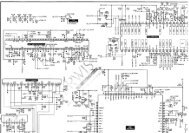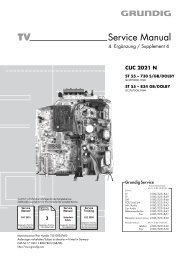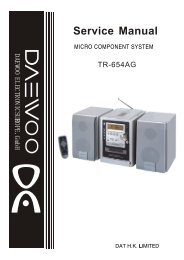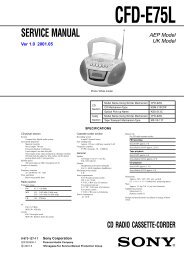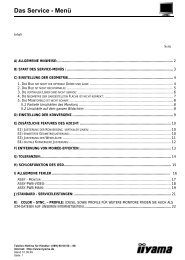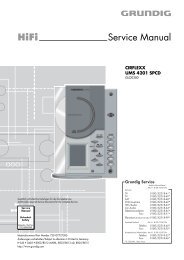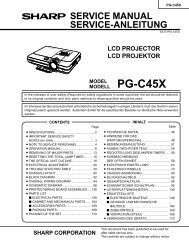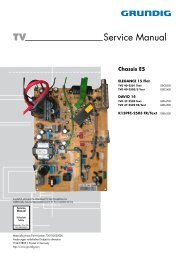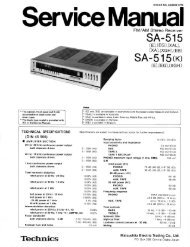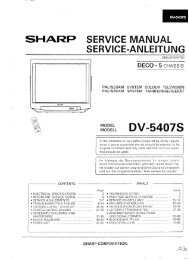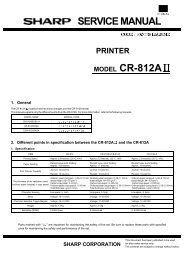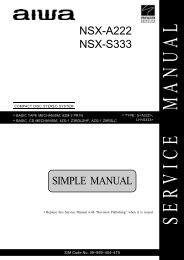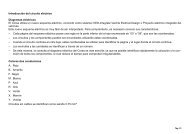SERVICE MANUAL
SERVICE MANUAL
SERVICE MANUAL
You also want an ePaper? Increase the reach of your titles
YUMPU automatically turns print PDFs into web optimized ePapers that Google loves.
3. Overall Level Characteristic and Distortion Factor<br />
Check<br />
Purpose:<br />
Check the record level, play level, and distortion factor against the<br />
reference input.<br />
Mode REC and PB (SP mode)<br />
Signal 400 Hz, –6.3 dBs<br />
Measurement point Audio output terminal<br />
Measurement equipment Audio level meter and<br />
distortion factor meter<br />
Specified value Playback level: –6.3 ± 2 dBs<br />
Distortion factor: 1% or less<br />
Confirmation Method:<br />
1) Supply an audio signal of 400 Hz, –6.3 dBs simultaneously to<br />
both L and R channels of Audio Line Input.<br />
2) Make recording<br />
3) Play back a recorded portion.<br />
4) Confirm that a playback level is –6.3 dBs.<br />
5) Confirm that a distortion factor is within 1%.<br />
4. Overall S/N Check<br />
Purpose:<br />
Confirm that the S/N is within the specification.<br />
Mode REC and PB (SP mode)<br />
Signal No signal<br />
Measurement point Audio output terminal<br />
Measurement equipment Audio level meter<br />
Specified value –67.5 dBs or less<br />
Confirmation Method:<br />
1) Connect both L and R channels of audio line input to the GND.<br />
2) Start recording.<br />
3) Play the recorded part to confirm that the noise is below –67.5<br />
dBs.<br />
7-6<br />
2-5-2. Normal Audio System Adjustment<br />
• Make adjustment in the SP mode, unless otherwise specified.<br />
Use a normal VHS cassette for an adjustment tape.<br />
• Set AUDIO MONITOR to normal.<br />
[Adjustment Sequence]<br />
1. ACE Head Adjustment<br />
2. E-E Output Level Check<br />
3. Frequency Responce Check<br />
4. Overall Level Characteristic and Distortion Factor<br />
Check<br />
5. Overall S/N Check<br />
1. ACE Head Adjustment<br />
Refer to the service manual of VHS MECHANICAL<br />
ADJUSTMENT IV.<br />
2. E-E Output Level Check<br />
Purpose:<br />
Confirm that the output level against the reference input is within<br />
the specification.<br />
Mode E-E<br />
Signal L, R: 400 Hz, –6.3 dBs<br />
Measurement point Audio output terminal<br />
Measurement equipment Audio level meter<br />
Specified value –6.3 ± 2 dBs<br />
Confirmation Method:<br />
1) Simultaneously input a signal of 400 Hz, –6.3 dBs to both L<br />
and R channels of Audio Line Input.<br />
2) Confirm that the audio output level is –6.3 ± 2 dBs.<br />
3. Frequency Responce Check<br />
Purpose:<br />
Confirm that the frequency characteristic is within the specification.<br />
Mode REC and PB (SP mode)<br />
Signal 400 Hz, –26.3 dBs<br />
7 kHz, –26.3 dBs<br />
Measurement point Audio output terminal<br />
Measurement equipment Audio level meter<br />
Specified value 0 ± 3 dB<br />
Tape path adjustment must have been completed.<br />
Confirmation Method:<br />
1) Supply a signal of 400 Hz, –26.3 dBs to both L and R channels<br />
of Audio Line Input.<br />
2) Connect the audio level meter to the Audio Line Output.<br />
3) Adjust the attenuator so that the audio level meter will indicate<br />
–26.3 dBs.<br />
4) Make recording in the SP mode.<br />
5) Set an audio line input signal to 7 kHz and make recording.<br />
6) Playback a recorded portion, and measure output levels at 400<br />
Hz and 7 kHz.<br />
7) Confirm that the 7 kHz playback output level within a range<br />
of the 400 Hz playback output level 0 ± 3 dB.



